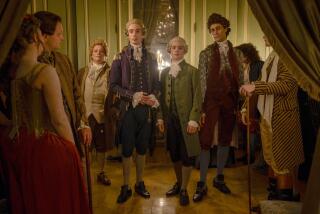He’s locked in on authenticity
- Share via
At 63, armorer R. Vern Crofoot likes 1870s percussion cap guns well enough, but it is Revolutionary-era flintlocks and their earlier predecessors, the matchlocks, that are his specialty and passion. “I like the artistry of the early weapons -- the balance, the beauty of them,” he says. “They were handmade pieces of art. And the flintlock was the zenith of the front-loading guns. After the flintlock, most of the percussion guns were much more of a tool than a work of art.”
Raised in Orlando, Fla., Crofoot hunted with muzzle-loading percussion guns beginning at around age 10. “I’ve killed wild hogs right where Disney’s property is, probably where Fantasyland and the castle [are]!”
His interest in early weaponry led him to join forces with a Revolutionary War reenactment unit in St. Augustine, Fla. Word of his expertise spread, and he was approached to consult for PBS and for films including “The Last of the Mohicans,” “Behind Enemy Lines,” “Master and Commander: The Far Side of the World,” “The Alamo” and “The New World.”
“Working a set, especially a weapons set, is 90% boredom and 10% panic,” he says. He spent the better part of a year experiencing both extremes as the master armorer on the set of HBO’s “John Adams” miniseries, which premieres tonight.
Don’t leave home without it: In Colonial America, everyone was armed and dangerous. “Your average individual at that time, even a gentleman of that era, would have been carrying a weapon at all times,” says Crofoot. “The police forces weren’t like they are today. You pretty much had to defend yourself. So to carry a small sword or a pocket pistol was a very common thing, and every person on the street, including women, would have been carrying a knife.”
A history of violence: On “John Adams,” Crofoot ensured that every character was carrying not just a weapon but the correct weapon.
“The only time John Adams ever carried a sword was when he went to court, and that was given to him so he could present himself to the queen,” he says. “We know he had a brace of pocket pistols. [In the miniseries], you’ll see Mrs. Adams grab a gun from above the fireplace when she hears the noise of the artillery coming by the place. That musket that she pulls down is a trade musket, and we know that the Adams family had a trade musket. It’s as correct as we could possibly make it. You’ll see two or three different types of guns, for instance, on the British soldiers. If it’s an American-raised regiment, the guns that they have are first-model Brown Besses, which is an earlier vintage gun. The later units that come in have second-model Brown Besses. Very minor differences, but anyone that’s a gun nut will know it.”
Armed to the teeth: Good dental hygiene was important during Adams’ day -- relatively speaking. “The requirement for being a soldier during the Revolutionary War was you had to have four good teeth, two uppers and two lowers opposing each other so you could tear the cartridge,” says Crofoot. “It’s a paper cartridge that has a charge of powder and a ball in it. I mean, you had to be able to tear the cartridge with your teeth, or you literally couldn’t pass the physical.”
Breaking the mold: Crofoot used a combination of original weapons, high-quality replicas and rubber copies. “I probably had 20 or 30 rubber muskets, rubber pistols, rubber swords,” he says. “For instance, if you’ve got a rider on a horse, and he’s not particularly good and is apt to fall off, you don’t give him a sharp pointy thing to fall on. So what we do is we’ll make a rubber replica of it. And if he falls off, he gets poked with a rubber pointy thing, not a sharp pointy thing.
“And the other thing is if we’re doing a stunt, believe it or not -- even though stuntmen get paid to take a chance on getting hurt -- they get a little upset when you beat them over the head with a musket that weighs 10 pounds. If I’m going to have somebody hit over the head with it, I make it out of a very soft rubber. Better that the gun goes ‘squidgie, squidgie’ than the guy’s head goes ‘squidgie, squidgie.’ ”
More to Read
Sign up for The Wild
We’ll help you find the best places to hike, bike and run, as well as the perfect silent spots for meditation and yoga.
You may occasionally receive promotional content from the Los Angeles Times.





